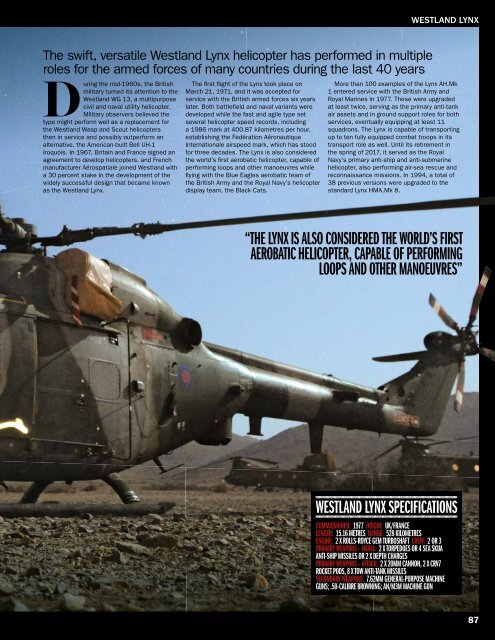Create successful ePaper yourself
Turn your PDF publications into a flip-book with our unique Google optimized e-Paper software.
WESTLAND LYNX<br />
The swift, versatile Westland Lynx helicopter has performed in multiple<br />
roles for the armed forces <strong>of</strong> many countries during the last 40 years<br />
During the mid-1960s, the British<br />
military turned its attention to the<br />
Westland WG 13, a multipurpose<br />
civil and naval utility helicopter.<br />
Military observers believed the<br />
type might perform well as a replacement for<br />
the Westland Wasp and Scout helicopters<br />
then in service and possibly outperform an<br />
alternative, the American-built Bell UH-1<br />
Iroquois. In 1967, Britain and France signed an<br />
agreement to develop helicopters, and French<br />
manufacturer Aérospatiale joined Westland with<br />
a 30 percent stake in the development <strong>of</strong> the<br />
widely successful design that became known<br />
as the Westland Lynx.<br />
The fi rst fl ight <strong>of</strong> the Lynx took place on<br />
March 21, 1971, and it was accepted for<br />
service with the British armed forces six years<br />
later. Both battlefi eld and naval variants were<br />
developed while the fast and agile type set<br />
several helicopter speed records, including<br />
a 1986 mark at 400.87 kilometres per hour,<br />
establishing the Fedération Aéronautique<br />
Internationale airspeed mark, which has stood<br />
for three decades. The Lynx is also considered<br />
the world’s fi rst aerobatic helicopter, capable <strong>of</strong><br />
performing loops and other manoeuvres while<br />
fl ying with the Blue Eagles aerobatic team <strong>of</strong><br />
the British Army and the Royal Navy’s helicopter<br />
display team, the Black Cats.<br />
More than 100 examples <strong>of</strong> the Lynx AH.Mk<br />
1 entered service with the British Army and<br />
Royal Marines in 1977. These were upgraded<br />
at least twice, serving as the primary anti-tank<br />
air assets and in ground support roles for both<br />
services, eventually equipping at least 11<br />
squadrons. The Lynx is capable <strong>of</strong> transporting<br />
up to ten fully equipped combat troops in its<br />
transport role as well. Until its retirement in<br />
the spring <strong>of</strong> <strong>2017</strong>, it served as the Royal<br />
Navy’s primary anti-ship and anti-submarine<br />
helicopter, also performing air-sea rescue and<br />
reconnaissance missions. In 1994, a total <strong>of</strong><br />
38 previous versions were upgraded to the<br />
standard Lynx HMA.Mk 8.<br />
“THE LYNX IS ALSO CONSIDERED THE WORLD’S FIRST<br />
AEROBATIC HELICOPTER, CAPABLE OF PERFORMING<br />
LOOPS AND OTHER MANOEUVRES”<br />
WESTLAND LYNX SPECIFICATIONS<br />
COMMISSIONED: 1977 ORIGIN: UK/FRANCE<br />
LENGTH: 15.16 METRES RANGE: 528 KILOMETRES<br />
ENGINE: 2 X ROLLS-ROYCE GEM TURBOSHAFT CREW: 2 OR 3<br />
PRIMARY WEAPONS – NAVAL: 2 X TORPEDOES OR 4 SEA SKUA<br />
ANTI-SHIP MISSILES OR 2 X DEPTH CHARGES<br />
PRIMARY WEAPONS – ATTACK: 2 X 20MM CANNON, 2 X CRV7<br />
ROCKET PODS, 8 X TOW ANTI-TANK MISSILES<br />
SECONDARY WEAPONS: 7.62MM GENERAL-PURPOSE MACHINE<br />
GUNS; .50-CALIBRE BROWNING; AN/M3M MACHINE GUN<br />
87


















